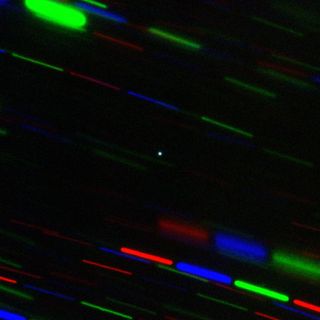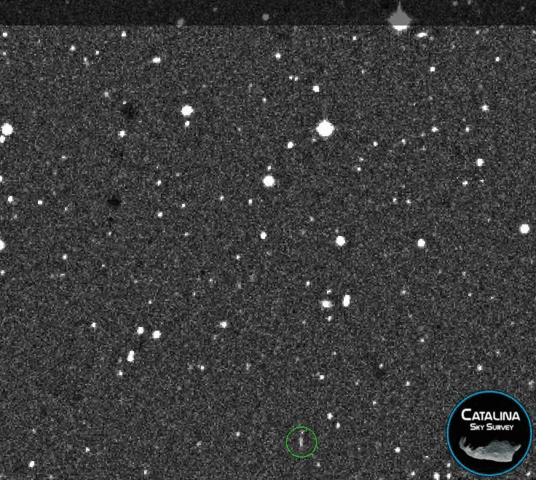How scientists found Earth's new minimoon and why it won't stay here forever
A weird "minimoon" found circling Earth likely won't be there long.
The scientists who discovered the object on Feb. 15 estimate that, because of the instability of its path through space, the minimoon will likely leave Earth's orbit sometime in April.
Astronomers know little about this minimoon — so little, in fact, that they can't even say if it's an artificial object, such as a dead satellite. However, they say, it's most likely a small asteroid. And although the object poses no danger to Earth, it does show how changeable our neighborhood is.
Video: 'Minimoon' discovered around Earth. Here's its orbit
Related: See the increase in near-Earth asteroids NASA has discovered (video)

Information from the International Astronomical Union's Minor Planet Center, which keeps observation records for all known asteroids, shows that the orbit of the minimoon doesn't match the precise orbit of any known human-made object, Kacper Wierzchos, a senior research specialist for the Catalina Sky Survey and co-discoverer of the minimoon, told Space.com. The object's orbit didn't display any perturbations resulting from solar radiation pressure coming from the sun; such wiggles are common for human-made satellites in Earth's orbit.
But Wierzchos said he doesn't want to assume the minimoon is an asteroid quite yet. "The possibility it is artificial still exists, so I am trying to be cautious with every statement," he said. "I'd hate it to be artificial after [everyone is] making a fuss [about the discovery]."
The NASA-funded Catalina program at the University of Arizona is an automated survey that scans the sky for fast-moving objects. On discovery night, Wierzchos and Catalina research specialist Theodore Pruyne happened to be at the telescope, Wierzchos said. On a good night, the survey can study around 40 near-Earth asteroids, which are typically objects astronomers already know about. But on Feb. 15, something in Catalina's observations looked a little funny and didn't match anything known by astronomers. The duo submitted the discovery to the Minor Planet Center, and other astronomers soon confirmed the find.
Get the Space.com Newsletter
Breaking space news, the latest updates on rocket launches, skywatching events and more!

The newly identified object, now known as 2020 CD3, was very faint when it was discovered, at only about magnitude 20. (The lower the magnitude, the brighter the object.) That faintness stretches the capabilities of Catalina and is beyond what most amateurs can see in their telescopes. (Since then, the object has faded to magnitude 23, making it visible only to the largest professional telescopes.)
In the nights after the discovery, Wierzchos and his collaborators kept following the object to try to determine its orbit. Their calculations showed that, most likely, the object was circling the sun and Earth's gravity snatched it into our planet's orbit sometime in 2017.
How did the minimoon go unnoticed for years? First, the sky is vast, and telescopes have limited time dedicated to searching for asteroids, Wierzchos said. He also cited the minimoon's faintness and highly variable orbit.
2020 CD3 has a "chaotic" orbit, he said, because it is pulled between the gravity of the moon and the gravity of Earth. Its distance to Earth varies between the equivalent of 0.2 and 4.5 Earth-moon distances (The average distance to the moon is roughly 239,000 miles, or 384,000 kilometers.) When Wierzchos last observed the minimoon, on Wednesday (Feb. 26), it was roughly 2.5 lunar distances away, he said.
Because the object's distance to Earth varies, so does its orbital period, or the time it takes the minimoon to circle Earth. Wierzchos said the object's orbital period is difficult to measure precisely, but it seems to be about a month.
Astronomers have observed 2020 CD3 only about six or seven times so far, so they don't have enough information yet to derive a "light curve," which shows the variation in an object's brightness. If they can get that data, Wierzchos said, it may help astronomers determine what kind of asteroid it is (if it is, indeed, an asteroid), how quickly it rotates and how big it is.
Assuming the object is a common type of asteroid called a carbonaceous asteroid, Wierzchos said, the minimoon is probably about the size of a car. Ideally, he hopes other telescopes will be able to observe the object before it drifts away. Telescopes he would like to see participate include Puerto Rico's Arecibo Observatory (which has radar optimized to get the shape and size of nearby asteroids) or large optical telescopes, such as the Keck Observatory in Hawaii.
Wierzchos is scouring past data from the Catalina Sky Survey to see if 2020 CD3 showed up in past imagery and went unnoticed. He hasn't found such observations yet, but he said it's possible that Catalina or other asteroid surveyors, such as the Asteroid Terrestrial-impact Last Alert System, have that information in their archives.
Wierzchos hopes Catalina will be able to see 2020 CD3 again before it fades. But astronomers are racing against the gravitational tug-of-war between Earth and our traditional moon. Before long, they know, the minimoon will drift out of sight, bound for new adventures.
- Amazing moon photos from NASA's Lunar Reconnaissance Orbiter
- A radar station in Puerto Rico can see ice on Mercury
- How an asteroid flyby in 2017 is helping NASA defend Earth from Armageddon
Follow Elizabeth Howell on Twitter @howellspace. Follow us on Twitter @Spacedotcom and on Facebook.
OFFER: Save at least 56% with our latest magazine deal!
All About Space magazine takes you on an awe-inspiring journey through our solar system and beyond, from the amazing technology and spacecraft that enables humanity to venture into orbit, to the complexities of space science.
Join our Space Forums to keep talking space on the latest missions, night sky and more! And if you have a news tip, correction or comment, let us know at: community@space.com.

Elizabeth Howell (she/her), Ph.D., is a staff writer in the spaceflight channel since 2022 covering diversity, education and gaming as well. She was contributing writer for Space.com for 10 years before joining full-time. Elizabeth's reporting includes multiple exclusives with the White House and Office of the Vice-President of the United States, an exclusive conversation with aspiring space tourist (and NSYNC bassist) Lance Bass, speaking several times with the International Space Station, witnessing five human spaceflight launches on two continents, flying parabolic, working inside a spacesuit, and participating in a simulated Mars mission. Her latest book, "Why Am I Taller?", is co-written with astronaut Dave Williams. Elizabeth holds a Ph.D. and M.Sc. in Space Studies from the University of North Dakota, a Bachelor of Journalism from Canada's Carleton University and a Bachelor of History from Canada's Athabasca University. Elizabeth is also a post-secondary instructor in communications and science at several institutions since 2015; her experience includes developing and teaching an astronomy course at Canada's Algonquin College (with Indigenous content as well) to more than 1,000 students since 2020. Elizabeth first got interested in space after watching the movie Apollo 13 in 1996, and still wants to be an astronaut someday. Mastodon: https://qoto.org/@howellspace
-
rod ReplyAdmin said:A weird "minimoon" found circling Earth likely won't be there long.
How scientists found Earth's new minimoon and why it won't stay here forever : Read more
Interesting images and video. As the report stated "The newly identified object, now known as 2020 CD3, was very faint when it was discovered, at only about magnitude 20. (The lower the magnitude, the brighter the object.) That faintness stretches the capabilities of Catalina and is beyond what most amateurs can see in their telescopes. (Since then, the object has faded to magnitude 23, making it visible only to the largest professional telescopes.)...2020 CD3 has a "chaotic" orbit, he said, because it is pulled between the gravity of the moon and the gravity of Earth. Its distance to Earth varies between the equivalent of 0.2 and 4.5 Earth-moon distances (The average distance to the moon is roughly 239,000 miles, or 384,000 kilometers.) When Wierzchos last observed the minimoon, on Wednesday (Feb. 26), it was roughly 2.5 lunar distances away, he said. Because the object's distance to Earth varies, so does its orbital period, or the time it takes the minimoon to circle Earth. Wierzchos said the object's orbital period is difficult to measure precisely, but it seems to be about a month."
It is a very small object and very faint as reported mv+20 on the apparent magnitude scale. As comparison my 10-inch telescope can see down to about mv+14.5 in very dark skies. Over the years, radar measurements record small asteroids moving past Earth at relatively close distances too measured in lunar distances. There is a population of small objects, NEA/NEOs, these orbit farther out but can cross inside Earth location, have short lifetimes in their present orbits, commonly <=2E+6 years. The solar system features many objects that indicate youth so reconciliation with radiometric ages for the Earth and solar system based upon meteorite dating is required.

